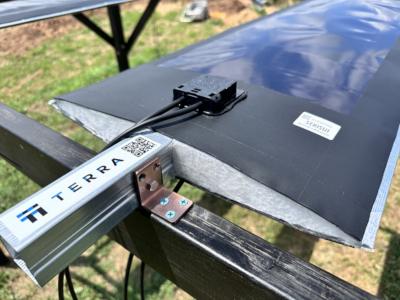Sekisui Chemical considers acquiring Sharp Osaka plant and turning it into a perovskite solar cell factory
Sekisui Chemical is reportedly considering acquiring part of Sharp Corp.'s plant in Osaka Prefecture, in order to use the facility to produce perovskite solar cells. The Company plans to commercialize these solar cells in 2025.
It was also said that Japan's industry ministry is likely to subsidize the project as it is expected to contribute to decarbonization.
Sekisui Chemical and TERRA commence joint demonstration test of agrivoltaic perovskite solar cells in Japan
Sekisui Chemical and TERRA recently announced that they have commenced the first joint demonstration test in Japan to install film-type perovskite solar cells for agrivoltaics (solar sharing) at Sosa City, Chiba Prefecture on August 2, 2024.
Sekisui Chemical has created a 30 cm-wide roll-to-roll manufacturing process utilizing its original “sealing, film formation, materials and process technology,” and has reportedly confirmed 10 years equivalent of outdoor durability, which is critical to the development of film-type perovskite solar cells. Furthermore, this manufacturing process has been successfully used to produce film-type perovskite solar cells with a power generation efficiency of 15.0%. Development is being accelerated to further improve durability and power generation efficiency, as well as to establish manufacturing technology for 1 m-wide rolls.
Japan to launch public-private group to promote use of perovskite solar cells
Last week, it was reported that the Japanese government estimates the need for electricity output to rise 35% to 50% by 2050 due to growing demand from semiconductor plants and data centers backing artificial intelligence (AI). Now, Japan's industry ministry has said that it will launch a public-private group this month with the aim of commercializing perovskite solar cells, which are thin, light and bendable. The consortium will see 150 public and private entities, including local governments, working together to accelerate the adoption of flexible perovskite solar panels.
Perovskite solar cells, which can be installed flexibly in various places, such as on walls, are believed to hold the key to Japan's push for renewable energy. As the first step, the consortium will set a target for perovskite cell capacity by 2040. Current projections point to 38.8 GW, with the possibility of exceeding the capacity of conventional solar panels (70 GW) in the next decade, reaching 84.2 GW in 2050.
Japan to promote perovskite solar technology through feed-in tariffs
According to reports, Japan's government plans to advance perovskite flexible solar power panels through the country's feed-in tariff system, seeking to encourage investment in the technology. The Ministry of Economy, Trade and Industry plans to set the price of energy produced from perovskite cells at 10 yen (6 cents) per kilowatt-hour or more, higher than the current level for solar power, starting as early as fiscal 2025.
Light, flexible perovskite cells can generate electricity in places where traditional solar panel installation is not feasible, such as building walls and windows. The base technology is Japanese, and Japanese companies are involved in vigorous R&D with emphasis on quality and durability. At the same time, Chinese companies have begun mass production and are leading in commercialization.
Sekisui Chemical to initiate perovskite PV production in Slovakia
Reports suggest that Slovakia’s Deputy Prime Minister and Minister of Economy, Denisa Sakova, has signed a memorandum of understanding with Japan's Sekisui Chemical.
Sekisui Chemical is designing lightweight perovskite solar technology and aims to commercialize its flexible panels in 2025. “We are interested not only in working together on the expansion of this technology in Slovakia, but at the same time we also want to explore the possibilities of locating the production of such panels in our country,” said Sakova.
Pagination
- Previous page
- Page 2
- Next page





